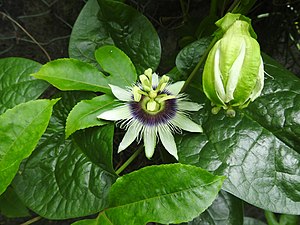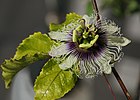Note: This is a project under development. The articles on this wiki are just being initiated and broadly incomplete. You can Help creating new pages.
Difference between revisions of "Passiflora edulis"
(→Identification) |
(→Flower) |
||
| Line 37: | Line 37: | ||
===Flower=== | ===Flower=== | ||
| − | {{Flower|Bisexual||Green sepals and 5 white petals||The flower has 5 oblong. The sepals and petals are 4-6mm in length and form a fringe | + | {{Flower|Bisexual||Green sepals and 5 white petals||The flower has 5 oblong. The sepals and petals are 4-6mm in length and form a fringe. Flowering from August to October}} |
===Fruit=== | ===Fruit=== | ||
Revision as of 13:04, 19 June 2023
Passiflora edulis is passion fruit is a vine species of passion flower native to southern Brazil through Paraguay and northern Argentina. It is cultivated commercially in tropical and subtropical areas for its sweet, seedy fruit, commonly called passion fruit.
Contents
- 1 Uses
- 2 Parts Used
- 3 Chemical Composition
- 4 Common names
- 5 Properties
- 6 Habit
- 7 Identification
- 8 List of Ayurvedic medicine in which the herb is used
- 9 Where to get the saplings
- 10 Mode of Propagation
- 11 How to plant/cultivate
- 12 Commonly seen growing in areas
- 13 Photo Gallery
- 14 References
- 15 External Links
Uses
Anxiety, Adjustment disorder, Hyperacidity, Joint pain, Fibromyalgia, Heart failure[1]
Parts Used
Chemical Composition
Luteolin (1), Apigenin (2), Luteolin 6-C-glucoside (3), Apigenin 6-C-glucoside (4), Three benzenoids, Vanillic acid (5), P-hydroxybenzoic acid (6), and Syringic acid (7), One quinol, 4-acetyl-3, 5-dimethoxy-p-quinol (8).[2]
Common names
| Language | Common name |
|---|---|
| Kannada | Gadiyaarada hoo, Jumaki hoo |
| Hindi | |
| Malayalam | |
| Tamil | |
| Telugu | |
| Marathi | NA |
| Gujarathi | NA |
| Punjabi | NA |
| Kashmiri | NA |
| Sanskrit | |
| English | Passion Fruit, Passion flower |
Properties
Reference: Dravya - Substance, Rasa - Taste, Guna - Qualities, Veerya - Potency, Vipaka - Post-digesion effect, Karma - Pharmacological activity, Prabhava - Therepeutics.
Dravya
Rasa
Guna
Veerya
Vipaka
Karma
Prabhava
Habit
Identification
Leaf
| Kind | Shape | Feature |
|---|---|---|
| Simple | Round in outline | Perennial vine; tendrils are borne in leaf axils, and have a red or purple hue when young |
Flower
| Type | Size | Color and composition | Stamen | More information |
|---|---|---|---|---|
| Bisexual | Green sepals and 5 white petals | The flower has 5 oblong. The sepals and petals are 4-6mm in length and form a fringe. Flowering from August to October |
Fruit
| Type | Size | Mass | Appearance | Seeds | More information |
|---|---|---|---|---|---|
| Simple Fruit | Ovoid | The fruit is 4—7.5 cm in diameter; purple fruits are smaller, weighing around 35 grams, while yellow fruits are closer to 80 grams. | Fruiting from August to October | {{{5}}} | {{{6}}} |
Other features
List of Ayurvedic medicine in which the herb is used
Where to get the saplings
Mode of Propagation
How to plant/cultivate
Passion fruit is widely grown in tropical and semitropical regions of the world.In the United States, it is grown in Florida, Hawaii, and California.[4]
Commonly seen growing in areas
Photo Gallery
References
- ↑ Karnataka Medicinal Plants Volume - 2 by Dr.M. R. Gurudeva, Page No. 443
- ↑ Chemical composition
- ↑ Morphology
- ↑ Cultivation Details
External Links
- Ayurvedic Herbs known to be helpful to treat Anxiety
- Ayurvedic Herbs known to be helpful to treat Adjustment disorder
- Ayurvedic Herbs known to be helpful to treat Hyperacidity
- Ayurvedic Herbs known to be helpful to treat Joint pain
- Ayurvedic Herbs known to be helpful to treat Fibromyalgia
- Ayurvedic Herbs known to be helpful to treat Heart failure
- Herbs with Fruits used in medicine
- Herbs with Leaves used in medicine
- Herbs with common name in Kannada
- Herbs with common name in English
- Habit - Herbs
- Index of Plants which can be propagated by Seeds
- Herbs that are commonly seen in the region of Tropical regions
- Herbs
- Passifloraceae




